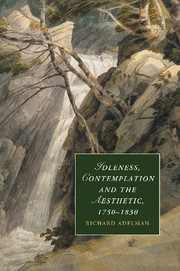Book contents
- Frontmatter
- Contents
- Acknowledgements
- List of abbreviations
- Introduction
- 1 The division of labour
- 2 Utilitarian education and aesthetic education
- 3 Cowper, Coleridge and Wollstonecraft
- 4 Coleridge's Pantisocracy, Biographia and Church and State
- Conclusion
- Epilogue: Wordsworth and Kingsley
- Notes
- Bibliography
- Index
- CAMBRIDGE STUDIES IN ROMANTICISM
1 - The division of labour
Published online by Cambridge University Press: 01 June 2011
- Frontmatter
- Contents
- Acknowledgements
- List of abbreviations
- Introduction
- 1 The division of labour
- 2 Utilitarian education and aesthetic education
- 3 Cowper, Coleridge and Wollstonecraft
- 4 Coleridge's Pantisocracy, Biographia and Church and State
- Conclusion
- Epilogue: Wordsworth and Kingsley
- Notes
- Bibliography
- Index
- CAMBRIDGE STUDIES IN ROMANTICISM
Summary
I want to begin by offering some observations on the pictures of the division of labour and commercial society put forward by Adam Smith and Adam Ferguson. The purpose of my doing this is to explore the significances of a notion of idleness or repose to these models, with a view to demonstrating that the positions from which Smith and Ferguson write turn on a conception of what it means to be in a state of inactivity. I seek to show that the concept of idle, private contemplation as somehow a purer, more intense and necessary mode of existence is almost impossible for them to avoid, despite their various tactics for doing so. Thus these two systems of thought, propounding fundamentally different priorities for the individual to follow and activities for him or her to engage in, must be seen to have important logistical similarities. Such similarities, moreover, carry important consequences for how we position both projects in relation to the type of thought that succeeds and opposes them. As we will see, these two versions of a grand narrative in fact open up fields of thought far removed from their premises and aims.
- Type
- Chapter
- Information
- Idleness, Contemplation and the Aesthetic, 1750–1830 , pp. 10 - 37Publisher: Cambridge University PressPrint publication year: 2011

